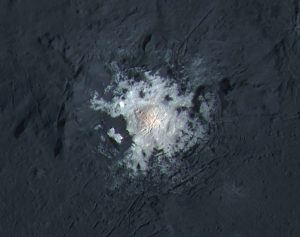The Astrowatch blog reports that the strange bright spots, first discovered on the dwarf planet Ceres by NASA’s Dawn spacecraft, continue to defy an easy explanation. A team led by Paolo Molaro of the Trieste Astronomical Observatory in Italy, following up on the Dawn observations conducted observations of these features, they found out something unexpected – the spots brightened during the day and also showed other variations. Scientists continue to debate if they are made of water ice, of evaporated salts, or something else.
Molaro and his colleagues studied the spots on Ceres in July and August 2015, using the High Accuracy Radial velocity Planet Searcher (HARPS), mounted on ESO’s 3.6m telescope at La Silla Observatory in Chile, which enables measurements of radial velocities with the highest accuracy currently available.
One of the proposed hypotheses is that these observed changes could be caused by volatile substances that evaporate during the day due to solar radiation. When the spots are on the day side illuminated by the sun, they form plumes that reflect sunlight very effectively. The scientists suggest that these plumes then evaporate quickly, lose reflectivity and produce the observed changes.
The team is currently applying for further observations by the end of this year, to repeat their observations for verification, and to look for additional changes. An important aspect of their work is to have shown a new way to study Ceres from ground, which could turn out to be useful even after the end of the Dawn mission.
Photos from the Dawn mission are part of CosmoQuest’s Asteroid Mappers project. Click here to learn more, and to help analyze data from the asteroid Vesta.







 Join the Crew!
Join the Crew!
 Escape Velocity Space News
Escape Velocity Space News
0 Comments